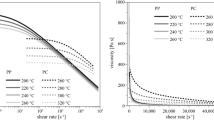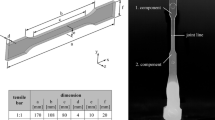Abstract
Micro injection moulding process represents a key technology for realizing micro components and micro devices used in several fields: IT components, biomedical and medical products, automotive industry, telecommunication area and aerospace. The development of new micro parts is highly dependent on manufacturing systems that can reliably and economically produce micro components in large quantities. In this work, the authors investigate the process parameters on the overall quality of a miniaturised dog-bone-shaped specimen in order to determine the process constraints. The factors affecting parts aspects and mass are studied by experimentation designed using DoE methodology and then discussed. Two polymer materials (polyoxymethylene and liquid crystal polymer), particularly suitable for injection moulding applications due to their flowability and stability, are tested and evaluated in relation to the process replication capability. It has been found that the holding pressure and holding time for POM and holding pressure and injection velocity for LCP have the highest influence on achieving high part mass. Differently, melt temperature has the highest influence on minimising the process variability for both tested polymers. A further investigation has been carried out on the relationship between the holding pressure and the part mass and dimensions demonstrating the existence of a linear correlation between specimens mass and dimensions.
Similar content being viewed by others
References
Xie L, Ziegmann G (2009) Influence of processing parameters on micro injection molded weld line mechanical properties of polypropylene (PP). Microsyst Technol 15:1427–1435
Min BH (2003) A study on quality monitoring of injection-molded parts. J Mater Process Tech 136:1–6
Piotter V, Bauer W, Benzler T, Emde A (2001) Injection molding of components for Microsystems. Microsyst Technol 7:99–102
Marson S, Attia UM, Allen DM, Tipler P, Jin J, Hedge J, Alcock JR (2009) Reconfigurable micro-mould for the manufacture of truly 3D polymer microfluidic devices. Proceedings of CIRP Design Conference 2009
Surace R, Trotta G, Bellantone V, Fassi I (2012) The micro injection moulding process for polymeric components manufacturing. In: Volosencu C (ed) New technologies—trends, innovations and research. Intech Publishing, Manhattan, pp 65–90
Whiteside BR, Martyn MT, Coates PD, Allan PS, Hornsby PR, Greenway G (2003) Micromoulding: process characteristics and product properties. Plast Rubber Compos 32:231–239
Griffiths CA, Dimov SS, Brousseau EB, Hoyle RT (2007) The effects of tool surface quality in micro injection moulding. J Mater Process Tech 189:418–427
Tadmor Z, Gogos CG (1979) Principles of polymer processing. Wiley, New York
Huang MS, Li JC, Huang YM, Hsieh LC (2009) Robust parameter design of micro-injection molded gears using a LIGA-like fabricated mold insert. J Mater Process Tech 209:5690–5701
Attia UM, Alcock JR (2010) Optimising process conditions for multiple quality criteria in micro-injection moulding. Int J Adv Manuf Technol 50:533–542
Sha B, Dimov S, Griffiths C, Packianather MS (2007) Investigation of micro-injection moulding: factors affecting the replication quality. J Mater Process Tech 183:284–296
Gornik C (2004) Injection moulding of parts with microstructured surfaces for medical applications. MacromolSymp 217:365
Monkonnen K, Hietala J, Paakkn P, Paakkn E, Kaikuta T, Pakkn T (2002) Replication of sub-micron features using amorphous thermoplastics. Polymer EngSci 42:1600–1608
Nagahanumaiah RB (2009) Effects of injection molding parameters on shrinkage and weight of plastic part produced by DMLS mold. Rapid Prototyping J15:179–186
Attia UM, Alcock JR (2011) Evaluating and controlling process variability in micro-injection moulding. Int J Adv Manuf Technol 52:183–194
Erzurumlu T, Ozcelik B (2006) Minimization of warpage and sink index in injection-molded thermoplastic parts using Taguchi optimization method. Mater Des 27:853–861
Vectra - Liquid crystal polymer (LCP) (2009) Manufacturer data sheet VC 7 5/06. http://www.ticona.com. Accessed 24 Sept 2010
Trotta G, Surace R, Modica F, Spina R, Fassi I (2010) Micro injection moulding of polymeric component. AIP Conference Proceedings, Proc of Int Confon Advances in Materials and Processing Technologies (AMPT2010), Paris, France 1315:1273–1278
Dormann B (2009) 2 K—Micro injection molding with formicaPlast ‘Industrial solution for precise mass production of micro parts’. Proceedings of 4 M/ICOMM 2009, pp. 347–349. doi: 10.1243/17547164C0012009072
Tosello G, Hansen HN, Dormann B, Decker C, Guerrier P. (2010) Process control and product evaluation in micro molding using a screwless/two-plunger injection unit. Proceedings of ANTEC 2010,Orlando, Florida USA, pp. 2161–2166
Modica F, Marrocco V, Trotta G, Fassi I (2011) Micro electro discharge milling of freeform micro-features with high aspect ratio. Proceedings of the 5th International Conference on Micro- and Nanosystems IDETC/MNS 2011, Washington, DC, USA
Montgomery DC (1997) Design and analysis of experiments, 4th edn. Wiley, New York
Gordon MJ (1993) Total quality process control for Injection molding. Carl Hanser, Munich
Minitab Inc. (2011) StatGuide™. http://www.minitab.com
Mani MR, Surace R, Segal J, Fassi I, Ratchev S (2011) Effects of process parameters on the quality of micro injection moulded parts. Proceedings of 8th Int. Conf. on Multi Material Micro Manufacture, 4 M 2011, Stuttgart, pp. 121–124
Ticona, VECTRA®, E130i, LCP Glass Reinforced-Data Sheet
Author information
Authors and Affiliations
Corresponding author
Rights and permissions
About this article
Cite this article
Bellantone, V., Surace, R., Trotta, G. et al. Replication capability of micro injection moulding process for polymeric parts manufacturing. Int J Adv Manuf Technol 67, 1407–1421 (2013). https://doi.org/10.1007/s00170-012-4577-2
Received:
Accepted:
Published:
Issue Date:
DOI: https://doi.org/10.1007/s00170-012-4577-2




